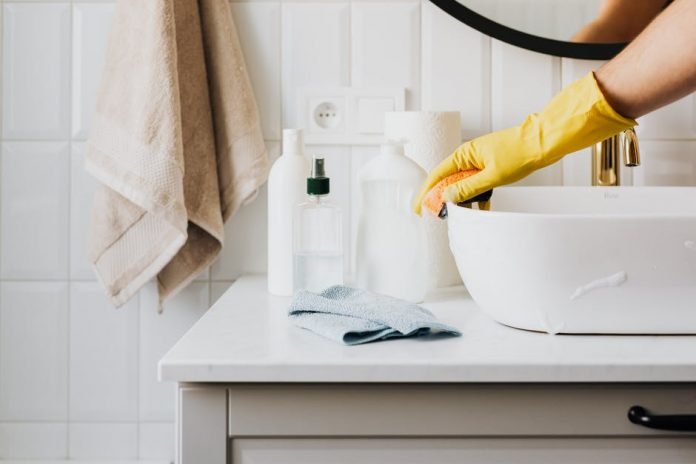Last Updated on January 18, 2024 by Umer Malik
The COVID-19 pandemic has certainly changed our attitudes towards cleanliness and public health. Even if you were something of a clean freak before, there’s been more attention put to germs and sanitization over the past two years than ever before.
If you’re still attempting to live up to the high standards associated with the modern moment, you might need a little assistance. Ensuring you are sanitizing surfaces in your home and workplace properly can go a long way towards ensuring you are providing a clean environment for yourself and those around you.
How can you master the sanitization process? Read on and we’ll walk you through what you need to know.
Table of Contents
Importance of Sanitizing Your Home
The spread of COVID-19 has made us more aware than ever of the pervasiveness of germs and micro-organisms that may enter our homes. While keeping a clean home is helpful and important, some people still undervalue the benefits of proper sanitization at home.
Sanitizing surfaces reduces the growth of all sorts of negative elements in your home: bacteria, viruses, fungi, and so on. Cleaning your home does not always cease the growth of these harmful organisms, but sanitizing will.
A good sanitizer will combat all sorts of different harmful bacteria. It’s important to keep contamination levels at home and work below certain levels, and the only way to reach this goal is to sanitize things properly.
When you leave and enter your home or workplace, you bring in bacteria from the outside world. This is why a regular sanitization schedule can be so important: it helps to combat the germs that we run into during our everyday lives.
Learning proper sanitation techniques for cleaning surfaces can ensure you and those around you stay healthy and safe.
Cleaning Surfaces Properly
When it comes to cleaning your home, you’ll want to put much of your attention on the areas that get the most activity. Counters, door handles, rails, light switches, and so forth. These are where you are most likely to transfer germs and bacteria from the outside world.
You should go beyond a light cleaning and regularly attack these kinds of surfaces with the best sanitizers you have on hand. Infectious disease experts, such as Moderna’s Kenneth Chien, have said time and time again that proper cleaning can help curb the spread of diseases that threaten our well-being.
The environmental protection agency lists and rates different sanitizing agents, so you can find products trusted to work. You can also rest assured these products won’t bring about any other type of harm to your family, pets, and plants.
When sanitizing, spray down a surface and then let the solution sit for anywhere from a minute to five minutes. Once the solution has been allowed to sit, you can begin to pat it down with dry paper towels.
With enough time and attention, you should be able to kill 99% of the bacteria and germs that may be existing on said surface, a huge achievement.
Remember to always follow instructions carefully when using disinfectants. Pay close attention to any hazard warnings or other important intel that might be included on the packaging itself.
Sanitizing Soft Surfaces
What does the sanitization process look like if you’re trying to clean a soft surface? This could mean things like carpets, rugs, drapes, or anything less than solid.
The best way to sanitize this type of surface is to pull out your soap and water and create a light mixture. If you can, launder these soft items with your mixture and then dry them completely before putting them back in place.
If you have products that are designed for these types of materials, you can use them in conjunction with your soapy water mix. It might be wise to wear a pair of disposable gloves like nitrile gloves latex free when working with laundered items until you are sure that they are clean.
It’s a good idea also to vacuum these surfaces regularly. It can help to combat dust, bacteria, and other potentially dangerous allergens. If you are vacuuming an area near where someone was sick within the past twenty-four hours, you might want to wear a mask while performing the task.
A vacuum can kick up bacteria and allergens into the air, making it easier for them to enter your body.
Sanitizing Electronics
We use all sorts of devices during our daily routines these days, and each one of them should be sanitized to ensure they are not spreading germs.
There are a number of ways to carefully sanitize these devices to ensure that you stay safe and that they stay working properly.
You might want to consider putting easy-to-clean covers on your electronics to help make them easier to clean. It’s much easier to clean a phone case than it is to clean an actual phone, for example.
Using a light disinfectant spray on a cloth can be the easiest way to clean most devices.
If you need to, refer to the owner’s manual for more specific instructions on how best to clean your devices without causing any sort of damage.
Guide to Sanitizing Surfaces
If you’re looking to ensure a clean and bright future for your home or workplace, you’ll need to ensure you understand the ins and outs of proper cleaning. Sanitizing surfaces is an essential cleanliness task, and learning the proper way to go about the process can be all-important.
Need more advice for the home or workplace? Keep scrolling our blog for more information.
Apart from this, if you are interested to know more about How to Sell Your Home Quickly (When You’re Not Getting Any Bites) then visit our Home Improvement category.



























